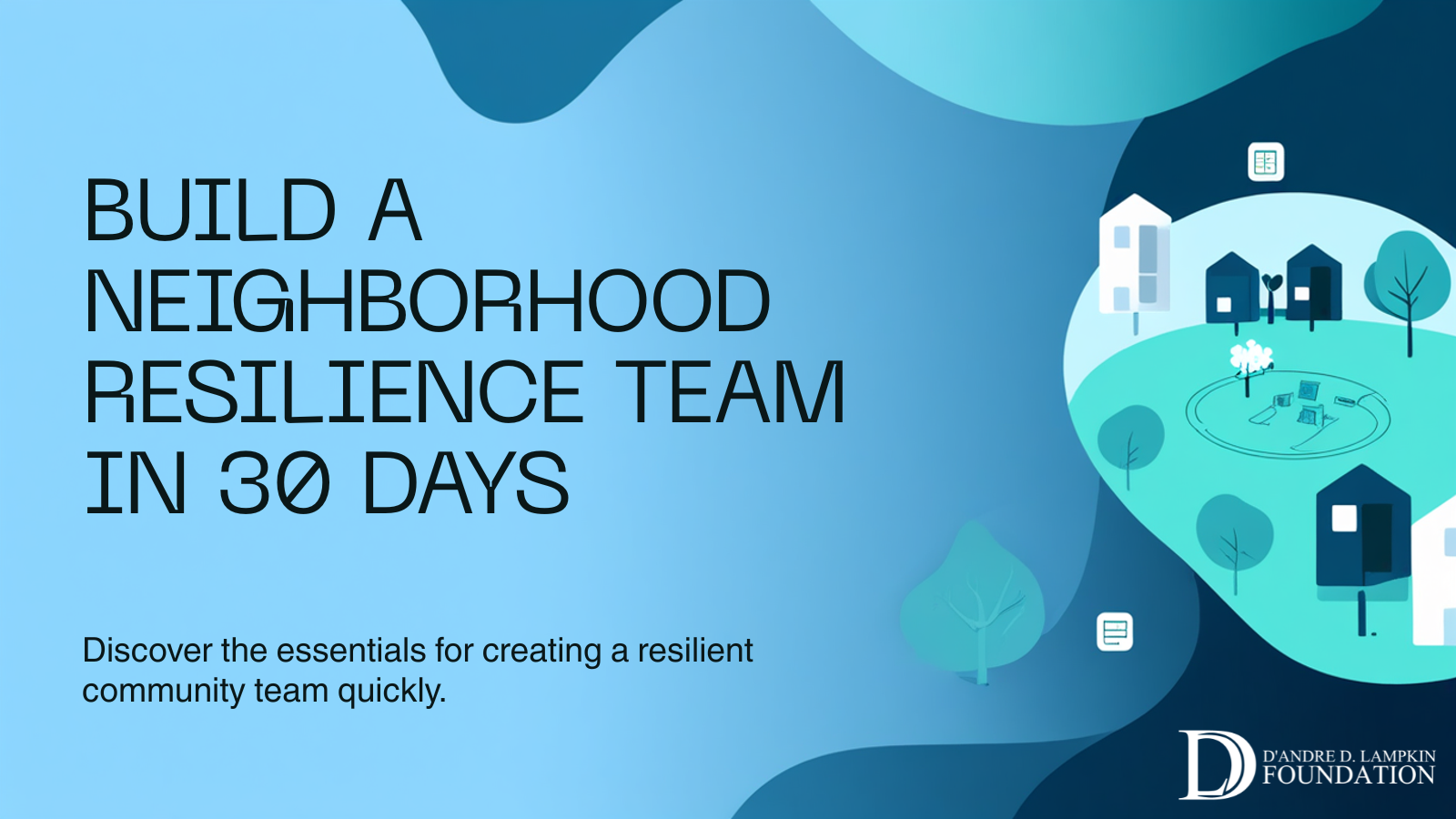
Why 30 Days Is Enough
When phones go dark and freeways clog, the first responders are neighbors. A resilient block doesn’t happen by accident—it’s built with clear roles, simple tools, and a quick plan you can practice together. This guide gives you a 30-day roadmap and a free starter kit (agenda, phone-tree, role cards, and a 20-minute micro-drill) to launch your neighborhood resilience team—without jargon, and without waiting for the “perfect time.”
Quick win: Schedule your 30-minute kickoff now. Momentum beats perfection.
Download: Neighborhood Resilience Starter Kit (PDF)
The 4-Week Launch Plan
Week 1: Rally Your Core Team (30 Minutes to Start)
Goal: Assemble 3–6 neighbors who are willing to help organize.
- Send a simple invite: “Quick 30-min chat to make sure our block can check on seniors, share updates, and coordinate if power or roads go down.”
- Kickoff agenda:
-
- Why we’re organizing (2 min)
- Map the block (5 min)
- Pick roles (10 min)
- Next steps + date for micro-drill (10 min)
- Pick simple roles: Coordinator, Communications, Wellness Checks, Supplies/Logistics, Pets & AFN (Access & Functional Needs), and a Backup Coordinator.
Deliverables: Meeting date set, roles drafted, list of immediate neighbors to contact.
Week 2: Map People, Skills, and Places
Goal: Know who and what is nearby—before you need it.
- People & skills: First-aid, languages, pickup truck, portable power, medical training.
- Places: Closest park, faith center, school, community room—spaces for a table, shade, or charging.
- Resources: Radios, flashlights, extension cords, coolers, pet carriers, backup meds (as appropriate).
- Phone tree: Build a layered contact tree (street by street or floor by floor). Include one out-of-area contact for mass texts when local networks are jammed.
Deliverables: Asset map (simple), phone tree (draft), consent to share limited contact info among team leads.
Week 3: Confirm Roles, Practice Communications
Goal: Everyone knows who does what, and how to reach one another.
- Role cards: Distribute cards so each lead has a clear checklist.
- Communications: Agree on primary + backup channels (text thread, group chat, radios, door-knocks).
- Wellness checks: Flag households needing extra support (seniors, mobility, medical devices). Keep that list confidential within the core team.
- Supplies snapshot: Create a short list of shared items your block can access quickly (extension cords, water jugs, chargers). Identify 2–3 small gaps to fill next month.
What does AFN mean?
Access & Functional Needs (AFN) refers to neighbors who may need additional support in emergencies due to age, disability (visible or invisible), language or literacy, transportation limits, or reliance on power-dependent medical equipment. Planning for AFN ensures everyone on the block can prepare, respond, and recover together.
Week 4: Run a 20-Minute Micro-Drill + After-Action Notes
Goal: Practice the plan end-to-end without stress.
- Script:
-
- “Power is out” scenario text at 6:00 PM.
- Communications Lead pings phone tree; neighbors confirm status.
- Wellness Lead checks 2 households on the priority list.
- Logistics Lead identifies a shaded meet-up spot (park/faith center) if needed.
- Coordinator logs outcomes on the After-Action Notes page.
- Debrief (5 minutes):
- What worked? What was slow? Who needs a backup?
- Update phone tree numbers.
- Pick the next micro-drill date (quarterly is great).
Deliverables: AAN completed, updated contact tree, next drill scheduled.
Partnering with Parks, VOAD/COAD, and Faith Networks
You don’t have to build this alone. Local Community Emergency Response Teams (CERT), local Emergency Managers, parks, faith communities, and VOAD/COAD partners are natural “connective tissue.”
- CERT Teams: Volunteers who are knowledgeable about disaster preparedness for the hazards that may occur in your area.
- Local Emergency Managers: City officials who coordinate a city’s preparedness for disasters by planning and implementing programs for disaster prevention, response, and recovery.
- Parks: Great for meet-ups, supply drop points, youth engagement, and lighting after dark.
- Faith & Community Centers: Rooms for briefings, fridge storage, or device charging (where possible).
- VOAD/COAD partners: Training, referrals, and tools your neighborhood can adapt.
Pro tip: Ask your nearest park or community center for a standing 30-minute room slot once a quarter to keep your team active.
What Success Looks Like (Simple Metrics You Can Track)
- Coverage: % of households on your phone tree (goal: 80%+ within 60 days).
- Response time: Minutes to confirm safety of priority households during your micro-drill (goal: under 15 minutes).
- Redundancy: Every role has at least one backup.
- Practice rate: One micro-drill per quarter, logged with a 1-page AAN.
- Neighbor confidence: One-question pulse check after each drill: “Do you feel more prepared?” (Yes/No).
Small wins stack. The first time your team helps a neighbor find a missing medication or checks on a caregiver during a blackout, your block will feel the difference.
FAQs
What if only two people show up?
Perfect. Start anyway. Assign two roles, build a mini phone tree, and run a 10-minute drill next week. Momentum attracts helpers.
Do we need radios?
Not to start. Prioritize a solid phone tree and door-knock plan. Radios can come later.
What about privacy?
Share only what neighbors consent to share (e.g., first name, unit, phone). Keep sensitive health info within the Wellness role and never publish it.
Ready? Download the Free Starter Kit
- Kickoff agenda (30 minutes)
- Role cards (Coordinator, Communications, Wellness, Logistics, Pets & AFN (Access & Functional Needs), Backup)
- Phone tree template (printable + fillable)
- Micro-drill script (20 minutes)
- After-Action Notes (1 page)
Download: Neighborhood Resilience Starter Kit (PDF)
Keep This Movement Going
Every time a neighborhood organizes, the whole county gets stronger. Your monthly support helps the Foundation print training packets, offer community workshops, and equip volunteers across parks, schools, and faith centers.
Become a monthly donor today:
- $15/month prints 50 wallet-cards for family communication plans.
- $35/month equips a neighborhood team with starter kits and checklists.
- $75/month helps train volunteer leaders to replicate this model block-by-block.



Leave a Reply
You must belogged in to post a comment.